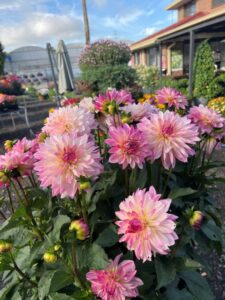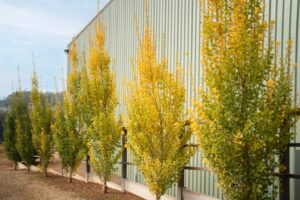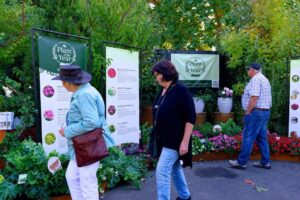
2025 Plant of the Year winners
By Gabrielle Stannus
Nursery and Garden Industry Victoria (NGIV) launched its inaugural Plant of the Year awards late last year, with the winners announced during the annual Australian Horticultural Trials Week in December. I spoke with the breeders and growers behind these plants at the Melbourne International Flower & Garden Show, where their award-winning cultivars were receiving much attention from those in attendance, to find out their landscape uses.
Before speaking with the breeders and growers, I firstly caught up with James Nicklen, Nursery and Garden Industry Victoria (NGIV)’s Communication and Marketing Specialist, in the Green Room at the Melbourne International Flower and Garden Show (MIFGS), where I asked him what these awards mean to the industry.
‘NGIV saw an opportunity to recognise innovation within the industry,’ says James, ‘For several years now, we have run our annual Australian Horticultural Trials Week where we see new introductions to the market and the passion of our growers. We also see the advancements in breeding that are happening within our membership base and beyond. We saw an opportunity to acknowledge and recognise that and create a bit of friendly competition.
‘We did not put any stipulations on who could enter. Being a Victorian association, a lot of the entrants were Victorian. However, we certainly welcomed other breeders or growers applying or nominating. We also left it open to the entrants to navigate the relationship between breeders and growers and determine who is best placed to submit the plant for nomination.’
Plants were evaluated based on criteria including aesthetic appeal, growth and performance characteristics, innovative qualities, and marketability potential. Applicants were required to provide supporting information about the nominated plants to address these three categories of criteria, which judges considered when making their decisions:
- Sensory appeal – each plant was evaluated based on its aesthetics, and overall visual impact, considering colour, form/habit, and texture, as well as unique or striking colours, patterns, fruit, foliage, and distinctive features that distinguish it within its botanical rank (genus, species).
- Growth & performance – each plant was evaluated on its ability to exhibit consistent and reliable performance, thrive with minimal inputs and resources, achieve excellent growth both in establishment and over the long term, display resistance to pests and diseases, tolerate environmental constraints, and demonstrate robustness in cultivation across diverse climate zones and versatility in garden or landscape applications.
- Innovation & marketability – each plant was evaluated on its potential commercial viability and alignment with market demand, as well as its uniqueness, origin story, or special attributes that enhance its appeal to consumers. Furthermore, judges considered its recreational value for both home gardeners and public spaces and educational potential for botanic gardens, schools, and horticultural programs.
When it came to judging the entrants, NGIV sought a range of industry perspectives. ‘We had retailers, landscapers, designers, and growers to ensure that we had a balance in the judging process,’ says James. The expert team of judges included Jane Jones (Janes Jones Landscapes), David Howard (Bay Road Nursery), Andrew Laidlaw (Royal Botanic Gardens), John Rayner (The University of Melbourne), Teena Crawford and Andrew Jones (Poyntons Nursery).
And the 2025 Plant of the Year winners were …
Shrub of the Year (and Overall Winner)
NGIV’s Shrub and overall Plant of the Year awards went to Runaway BrideTM Hydrangea, a hybrid brought to market in Australia by Plants Management Australia (PMA).

‘We are proud that Runaway Bride TM Hydrangea took out the best Shrub and Plant of the Year as it took us a long time to get that plant into the country,’ says Bonnie-Marie Barnsley, PMA’s Business, Communications and Marketing Manager, ‘We first saw it before it was awarded Plant of the Year at the RHS Chelsea Flower Show in 2018. It took us about seven to eight years to get this cultivar into Australia and through quarantine before we could start our research and development to make sure it would perform and grow in this country.
‘Runaway Bride TM comes from a breeder out of Japan, Ushio Sakazaki. He is world famous for his breeding in petunias, petchoas and calibrachoas. Mr Sakazaki had a passion for hydrangeas, and he would hike the mountains in Japan, finding wild specimens. These were then taken back to his breeding program and crossbreed with them. Runaway Bride TM, the world’s first garland hydrangea, came out of that cross breeding. It flowers at every bud terminal, and it is pruneless. It has this beautiful, semi-prostrate, cascading form. You can grow it as a semi-formal or informal hedge, garden bed filler, topiary, or as a single feature specimen. Its cascading habit is well suited to baskets or large urns. It can also be espaliered on vertical structures or used in floral arrangements.
‘The deciduous nature of this hydrangea also adds a seasonal element of interest. It flowers from spring through to summer, with hints in autumn. From autumn the foliage then transitions in colour from green to beautiful red, orange and yellow tones as it enters dormancy.’
Runaway Bride™ can grow to a height of 1.2m with a spread of 1.5m. It is best grown in moist to well-draining clay-loam soils and has moderate water requirements once established. It is frost hardy, tolerating temperatures to -10°C. In warmer climates, protect it from hot westerly aspects.
‘Runaway Bride is low maintenance; however, it does love its food so do not be afraid to give it a little bit of fertiliser throughout the year. Our recommendations are twice in spring and then again in autumn with an all-purpose fertiliser,’ adds Bonnie,
‘Basal shoots should be allowed to grow as they will form the flowering stems in the next year. The retention of these basal shoots is critical if you want to achieve the magical ‘garland’ growing habit, so do not prune!’
NB. This variety’s full name is Runaway Bride™ Hydrangea ‘USHYD0405’
Tree of the Year
The Tree of the Year award also went to PMA for Ginkgo biloba ‘Lemonlime Spire’.
Ginkgo ‘Lemonlime Spire’ is a cultivar selected for its narrow, upright habit and attractive lime-to-gold autumn foliage. ‘It is a brand-new landscaping solution for urban greenlife. Where we would traditionally use a narrow tree like a capital pear (Pyrus calleryana ‘Capital’) in a landscape, Ginkgo ‘Lemonlime Spire’ could be a good substitute to those types of applications,’ says Bonnie-Marie.

‘The beauty of Ginkgo ‘Lemonlime Spire’ lies in its narrow and fastigiate habit. Unlike traditional ginkgoes that are very broad, this ginkgo is only one metre wide by five metres tall. It can do a lot for urban spaces including inner-city landscapes or balconies. It looks beautiful in an avenue, along a fence line, or as a containerised feature tree. If you have a large wine barrel, that will happily accommodate this ginkgo’s root system, which is quite fibrous and non-invasive. At one of our trial gardens, there is a whole avenue of these ginkgoes along a retaining wall. They are mature trees, and they have not caused any buckling or damage to that wall. This gingko is a great space saver and solution for people who have limited space.’
Bonnie-Marie says that Ginkgo ‘Lemonlime Spire’ is a super low maintenance tree great for new or experienced gardeners, ‘A good soil will do wonders for them; however, they are adaptable. I wouldn’t say they are as suitable for salty conditions; I don’t think any ginkgo would be. Whilst they love full sun, they will take slightly more shady areas. Once again, you get that beautiful autumnal colouring with them. Give them good watering in the first 18 months of their establishment and then after that, they are mostly self-caring.’
To find a supplier of Ginkgo ‘Lemonlime Spire’ or Runaway BrideTM Hydrangea in your state, visit PMA’s support centre: www.supportcentre.pma.com.au or email info@pma.com.au.
Herbaceous Plant of the Year
The Herbaceous Plant of the Year award went to Dahlia x hybrida ‘Sincerity Rose Bicolour’, jointly entered in NGIV’s competition in a partnership between Syngenta flowers and JD Propagation.
‘A lot of breeders are from European based countries where garden space is limited. Some of the breeding today is more about pot rather than garden performance. Dahlia ‘Sincerity Rose Bicolour’ perfor’ms well in both situations,’ says Dan Patience, Managing Director of JD Propagation, ‘There is that place for people with small yards and small gardens that just want a small plant on a patio. However, in Australia, consumers still want plants with some size to fill out their gardens.
‘As a landscape planting on mass, Dahlia ‘Sincerity Rose Bicolour’ looks phenomenal. It flowers heavily, and its large flowers have a unique pink and white bicolour, the colour of which just keeps on going. Contrast this with the dark green foliage, and you have a plant that presents very well. This dahlia will grow to around 50 to 60 centimetres in height. It provides cut flowers for indoors, whilst retaining its performance in the garden given its vigour. And being a dahlia, you get the tuber that keeps coming up every year.’
When asked about growing conditions, Dan says climate is not a problem, ‘Obviously, the northern regions (of Australia) have a shorter winter period, so they get a longer flowering period. The key issue is making sure you remove dead flowers to promote more growth because you just get much higher flower count there as with most flowering products. It handles most soil types. It is quite robust, but you do not want a soil that is too acidic or too alkaline either way.’
Dan says business is generally booming on the dahlia side with a wide range of height and flowering sizes available in this genus, be it for packs or pots, small gardens or larger landscapes. He tells me to look out for Dahlia ‘Sincerity Peach’ coming onto the market soon.
In the meantime, Dahlia ‘Sincerity Rose Bicolour’ is available through the following wholesalers: Scotts Tubes and The Green Gallery (NSW); Pohlmans (Queensland); Poplar Grove (SA); Tibballs Nursery (TAS); Plantex Nursery, Regal Blooms, Scotsburn Nurseries and Southern Plants (VIC); Hope Valley (WA).
Specialist Plant of the Year
The Specialist Plant of the Year award went to Ground Hug™ Myoporum insulare, a groundcover from Ozbreed.
‘This is recognition for our head breeder, Todd Layt, and his blood, sweat and tears,’ explains Ozbreed’s Daniel Fuller, ‘Plant breeders are never quite sure which plant is going to work; they ‘delete’ thousands of plants waiting for ‘the one’. Todd saw something in this Myoporum insulare variety that was growing completely flat instead of the more common habit of shrub, and he was able to see the landscape functions it would fill. I believe there were only two survivors of the extreme flooding events in Windsor, NSW, over the recent years; however, the clear winner was Ground Hug TM Myoporum which not only performed better but also just looked a lot better.

‘Ground HugTM Myoporum is a shrubby groundcover that grows to ten centimetres, sometimes up to 20 centimetres after a decade of layering in the landscape. No pruning is needed to control its height. Its ornamental appeal is the clean foliage that is extra dense due to shorter internodes, but it also has subtle white flowers that feed pollinators. In our insect biodiversity sticky trap field study in September last year, we observed lots of fungus-eating insects near this plant. We recorded 155 shining flower beetles on Ground HugTM Myoporum compared with the average of 8.5 throughout the site. This makes me think that this myoporum might be good at stabilising the soil systems from a bacterial-dominant system to a fungal-dominant system. We are looking to do further studies to test this.
‘I also like to think of this myoporum as a living mulch. The idea is that this just stays in place and continuously sends down root exudates from photosynthesis including organic carbon into the soil. Plant this around trees and you encourage all sorts of good stuff to happen in the soil. In grasslands and wildflower meadows, you get a lot of herbaceous plants, and they break down quickly. That is good for swiftly adding nutrients and improving soil quality; however, that nutrient supply can rapidly burn out. Whereas woody plants, particularly Ground HugTM Myoporum take longer to break down, encouraging fungi in the soil, which is more beneficial for stabilising the landscape.’

Ground HugTM Myoporum thrives in full sun and is tolerant of frost, drought, coastal conditions, and various soil pH levels. It is suitable for most landscapes within 100km of the coast across Northern NSW, Victoria, SA, WA, and Tasmania. Improved frost resistance down to -5°C allows further inland growth. And it has edible berries! Although the leaves are toxic. Cultivation and maintenance requirements are relatively simple.
‘A formative cut of the initial leading stem helps it grow outward instead of upward, and we require nurseries to do this. However, it is not the biggest deal if you skip that step as the plant rights itself before long,’ says Daniel, adding that annual edge pruning should be undertaken if you want to control its spread.
Ground HugTM Myoporum is available wholesale through Domus Nursery (WA), Grove Propagation Nursery (WA), Kellyville Plant Patch (NSW), and The Plant Hub, which ships to NSW, ACT, Victoria, South Australia, and Queensland.
NB. This variety’s full name is Ground Hug™ Myoporum insulare ‘MYIN01′ PBR .
2026 Plant of the Year
Interested in nominating your plant for the 2026 Plant of the Year awards?
Outside of the broad ranging industry accolades, recognition in this award program brings marketing opportunities to its winners, including a high-profile presence at MIFGS, with the overall Plant of the Year award winner placed on display on the main stage and included in the professionally designed and built Plant of the Year Garden. Additionally, all category award winners and highly commended entries have a prominent public facing position at the show, with consumer information, gracing the entry to the NGIV Green Room. NGIV provides award badges for use on plant labels and promotion in and on their communication channels, including their Groundswell magazine and online newsletters.
Nominations will open mid-year, and close at the end of October with judging shortly after that. Winners will be celebrated at the Australian Horticultural Trials Week in December.
For more information, visit NGIV’s Plant of the Year website: www.plantoftheyear.com.au/
Gabrielle Stannus
Inwardout Studio
M: 0400 431 277
E: gabrielle@inwardoutstudio.com
